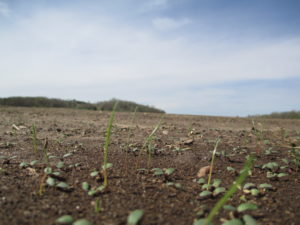Summer Seeding Alfalfa After Wheat
By Jan Motz | June 27, 2022
Far and wide a popular practice in Michigan is fall seeding alfalfa after wheat. This is a prime opportunity with a lull in the action between summer activities and fall harvest. But there are some critical steps to get the stand off to a good start, setting the stage for the subsequent life of the stand.
The foremost concern with establishing alfalfa stands is excellent weed control. Managing weed pressure while the alfalfa seedlings are growing is a difficult task especially in conventional alfalfa where chemical control options are few and far between. An effective tactic is to manage with tillage. Begin with a primary tillage pass and allow time for the first flush of weeds to grow, then continue with the secondary finishing passes.

Of course, the first weed that comes to mind is volunteer wheat. Depending on the severity of the growth it has potential to cause problems for alfalfa seedlings, shading them out and robbing critical moisture. It’s recommended to spray clethodim to kill the volunteer wheat. It is tempting to wait to spray the volunteer wheat to make sure to give as much of it as possible a chance to start growing, however waiting too long will allow the wheat time to out compete the alfalfa.
On the topic of chemistry, be mindful of herbicide carryover from previous crops. Some herbicides used previously on wheat or other row crops may have a long carryover and could result in a stand failure.
When it comes to fertility, be certain to take a soil test to know your starting point. It is important to maintain a pH of 6.7-7.0. Wheat straw removes 14 pounds of Nitrogen, 3.3 pounds of Phosphorous, and 24 pounds of Potassium per ton of straw. With a 50-bushel crop producing about two tons of straw per acre, a fertilizer application may be necessary based on your soil test to maintain proper potassium and phosphorous levels.
Insect damage is something to watch out for. Potato Leafhopper (PLH) can be particularly devastating to an establishing stand. Infected plants are stunted by compounds in the Potato Leafhopper’s saliva and may have more issues with winterkill. Scouting weekly for PLH is ideal to monitor their presence, and if an economic threshold is re

ached, insecticides can be effective in killing PLH. If you have had issues consistently with PLH, you may consider trying Legacy Seeds Hoppernot Max alfalfa, a Potato Leafhopper resistant variety.
Lastly, with summer seedings moisture can be hard to come by at times. Despite this avoid planting deeper than 1/4 inch. Planting deeper, trying to plant into moisture may result in planting dying off before they make it out of the ground. But above all else take the time to make the field smooth, and plant into a firm seedbed. Alfalfa is a long-term commitment and worth doing it right – because nobody likes a rough hayfield.
For more information or recommendations for your alfalfa field contact DF Seeds Feed and Forage Specialist, Darren Kulicamp.

